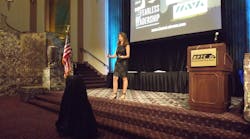CINCINNATI. If you want to make a splash with a keynote speaker, there are few ways more effective than calling upon a Vixen. Yes, the Vixen in question referred to herself that way. In fact, that was her call sign.
“My name is Carey Lohrenz, call sign Vixen,” is how former U.S. Navy F-14 Tomcat fighter pilot Carey Lohrenz introduced herself to the crowd during the keynote opening address for the National Private Truck Council’s 2015 Annual Education Management Conference and Exhibition, held in the Hall of Mirrors ballroom at the Hilton Cincinnati Netherland Plaza. “As Gary [Petty, NPTC president] said, I worked a little bit in the delivery business.”
And with that, Lohrenz, who was the first female F-14 fighter pilot in the Navy, told of some of her exploits in the Navy, but more importantly, left the audience of over 1,000 NPTC attendees with this simple message: don’t be afraid to try and push the envelope.
Lohrenz, who has written a book entitled Fearless Leadership (available in major retailers, online and at www.careylohrenz.com, proceeds go to the Iraq and Afghanistan Veterans of America), expertly entwined her experiences in the cockpit with how private fleet professionals can show leadership in their everyday operations.
“This is not about one person in the cockpit, or two people in the aircraft,” she said. “It takes a high-performing team and one that is not all celebrated.
“For instance, every nine months, half the population of an aircraft carrier turns over. That means every 18 months, it is 100% turnover, and it is never fully staffed,” Lohrenz explained. “Everybody who works on that ship of 5,000 people, whether you work in the nuclear reactor room or the flight deck, are working toward one goal and that is to get planes safely on and off that ship.”
Lohrenz went to tell the audience that you needed to “be a catalyst.”
“A catalyst is a person who leads a team, be it a team of 2, 20 or 100, who can come and get people working toward a single goal quickly,” she said.
“When people say we’ve never done it that way, or we can’t do it, find a third way.”
A good rule of thumb to follow is the 75% rule, Lohrenz said. When you have 75% of the data needed, start working toward the goal. “If you don’t do something quickly, someone else will,” she said. “If you are not continuously learning, you will lag behind very quickly.”
One of the keys to this approach, though, is the debriefing process, Lohrenz said. Without a debriefing process, you can’t learn from mistakes and improve operations going forward.
“If you don’t debrief, then 75% is not enough. That’s how we are able to take bold actions, by debriefing,” she added.
She also noted three areas to address: purpose, focus and discipline.
“Understanding what your purpose is and communicating that to your team [is important],” Lohrenz said. “It’s not some $200,000 plan, it’s communicating the purpose to your team. “
She added that “you can’t have 27 most important things to do,” and then challenged the audience to go home and come up with four or five things to focus on and then weave in others as needed.
“If you lose sight, you lose the fight,” Lohrenz said. “When we are afraid to fail, we pass up really valuable learning opportunities. So don’t be afraid to fail. It’s about your mindset and whether you are ready to accept failure.”
Among her final points was not to accept the status quo.
“When people say we’ve never done it that way, or we can’t do it, find a third way,” Lohrenz said, before relating a story about her commanding officer telling her she couldn’t be a fighter pilot because women, at the time, were not allowed in combat. He gave her a choice, she said: “You can move into a non-combat position or leave the Navy.”
She left for a little while before returning to his office and telling him that he had to find a third way. Eventually, Congress changed the rules regarding women in combat and Lohrenz went on to become perhaps the most famous female fighter pilot in the country’s history, all because she sought out a third way.



